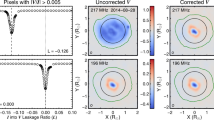Abstract
High-sensitivity measurements for mapping coronal magnetic field have become possible since the recent development of infrared detection techniques. One urgent task that arises from the routine infrared observations is to interpret what the Stokes signals could indicate for coronal magnetic fields. It is the first time for us to successfully reveal the coronal field structure above a simple and stable sunspot on the photosphere using profiles of full Stokes parameters. In this paper, the author further points out the deficiency in any conclusions/judgements just based on incomplete polarization data. A magnetic flux reversal feature, observed from circular polarization data, may correspond to one or more coronal tubes with their front or farside arching apex there, more complicated than people imagined before. To exactly locate the infrared radiation sources, we need both circular and linear polarization data for an integrated analysis of them.
Similar content being viewed by others
References
Kuhn J R. Infrared coronal magnetic field measurements. IR Tools for Solar Astrophysics: What’s Next? Kuhn J R, Penn M J, eds. Singapore: World Scientific, 1995. 89–93
Lin H, Penn M J, Tomczyk S. A new precise measurement of the coronal magnetic field strength. Astrophy J Lett, 2000, 541: 83–86
Lin H, Kuhn J R, Coulter R. Coronal magnetic field measurements. Astrophys J Lett, 2004, 613: 177–180
Casini R, Judge P G. Spectral lines for polarization measurements of the coronal magnetic field. II. Consistent treatment of the Stokes vector for magnetic-dipole transitions. Astrophys J, 1999, 522: 524–539
Lin H, Casini R. A classical theory of coronal emission line polarization. Astrophys J, 2000, 542: 528–534
Kuhn J R, Coulter R, Lin H, et al. The SOLARC off-axis corongraph. SPIE, 2003, 4853: 318–326
Liu Y, Lin H. Observational test of coronal magnetic field models. I. Comparison with potential field model. Astrophys J, 2008, 680: 1496–1507
Metcalf T R, Leka K D, Mickey D L. Magnetic free energy in NOAA active region 10486 on 2003 October 29. Astrophys J Lett, 2005, 623: 53–56
Liu Y, Zhang H. Global magnetic extrapolation based on the synoptic map of MDI/SOHO. Publ Yunnan Obs, 2002, 92: 1–9
Liu Y. Coronal magnetic fields inferred from IR wavelength and comparison with EUV observations. Ann Geophys, 2009, 27: 2771–2777
Bao X, Zhang Z, Deng J, et al. Near infrared spectral and polarization imaging observation of coronal emission lines during 2008 solar eclipse. Sci China Ser G-Phys Mech Astron, 2009, 52: 1794–1798
Author information
Authors and Affiliations
Corresponding author
Additional information
Supported by the National Natural Science Foundation of China (Grant Nos. 10843010 and 10933003)
Rights and permissions
About this article
Cite this article
Liu, Y., Shen, Y. The coronal magnetic field reversal observed by the SOLARC instrument. Sci. China Ser. G-Phys. Mech. Astron. 52, 1696–1701 (2009). https://doi.org/10.1007/s11433-009-0248-1
Received:
Accepted:
Published:
Issue Date:
DOI: https://doi.org/10.1007/s11433-009-0248-1




